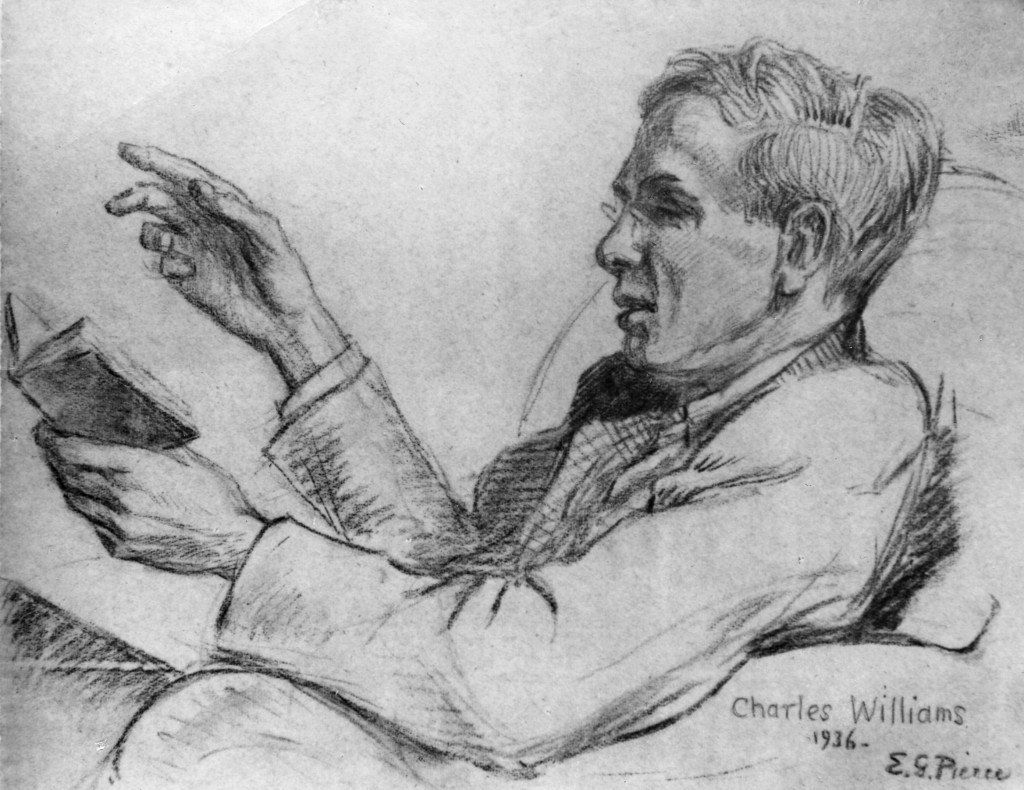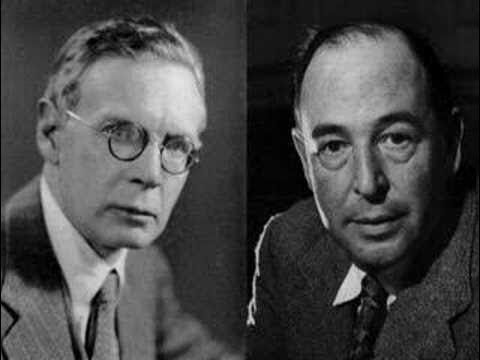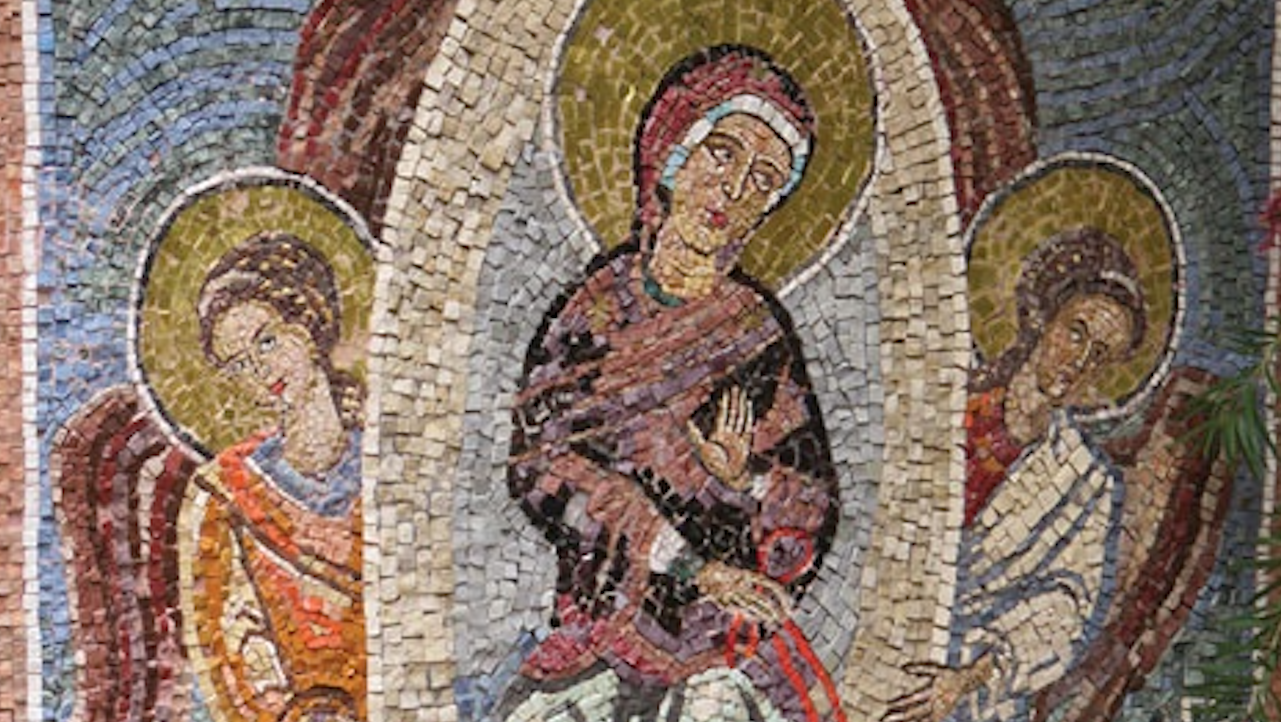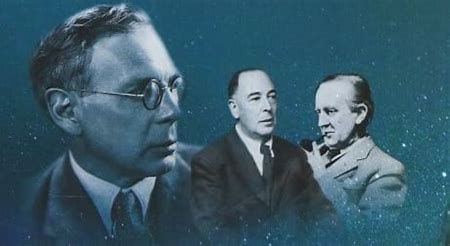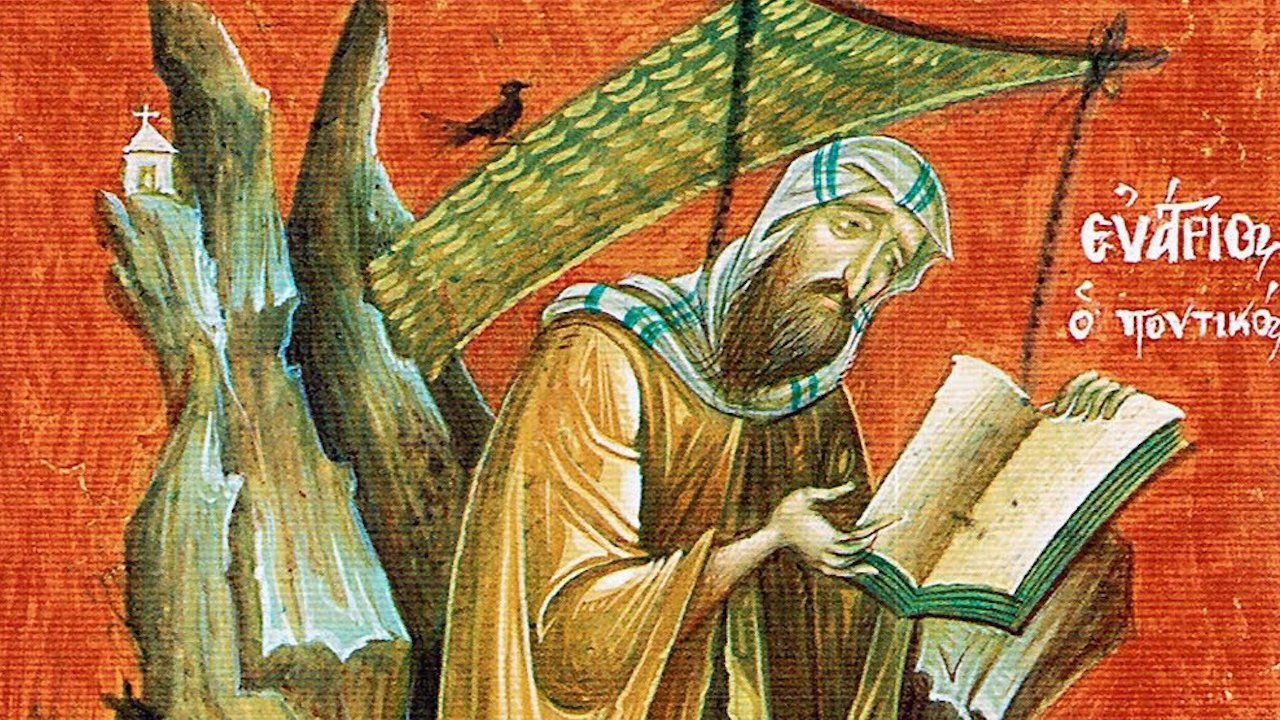The Desert Fathers and Ourselves
by Philip Sherrard
Feast of the Venerable Theophanes the Merciful of Gaza
Anno Domini 2020, September 29

“Just as a man whose head is submerged in the water cannot breathe the subtle air which is poured upon the atmosphere’s empty gulf, so he who immerses his mind in the cares of the present life cannot take in the breath that is a perception of the new world.” ~St. Isaac the Syrian
It is sometimes said that the forms of evil with which the desert fathers had to contend are basically the same as those we face today. But is this the case? The evils with which the desert fathers had to contend—death, pestilence, demons, and so on—are endemic to human life in its fallen state and are “natural” consequences of the fall. They could be made sense of, were within the scope of human comprehension, and through a process of askesis leading to purification could be allayed or transcended. And such an askesis did not involve participation in, or contributing to, activities and practices whose consequences are the perversion or abuse of the natural order. There was a correspondence between the way the ascetic perceived and related to the created world, the forms within which he lived his life, and the actual reality of the created world; he recognized that the will of the Creator is the nature of each thing that is created, and that unless things are treated and used in a way that accords with their nature, we violate God’s will and blaspheme against His nature.
Such correspondence and recognition also had their place in life within society. The forms of life within which man lived even when he lived in society were not in themselves evil—in fact, they were often imbued with divine beauty and wisdom, in such a way that merely living within them related him directly to God. The evil that people manifested within these forms was largely the consequence of their own individual choices, independently of the forms, and it did not contaminate the forms themselves. If one purified oneself through askesis one could live within the forms of society without contributing to or conniving in activities and practices that directly perverted or abused God’s creation and blasphemed God.
Our situation today is totally different from this. Of course we still have to contend, as the desert fathers had to, with the forms of evil endemic to the fallen human state. But, as a consequence of choices made by individuals and increasingly tolerated when not actively supported and subscribed to by society as a whole, we are now forced to live in society, if not in the world at large, according to forms that not only do not correspond in any way to the reality of the divine, human, or natural order, but are themselves actively and positively evil to a degree that goes far beyond the evil inevitably endemic to the fallen human state or that is a “natural” consequence of the fall; for these forms in themselves represent and demand the violation of the divine, human, or natural order, and hence represent and demand a denial of God’s will. It is as if there has been a kind of second fall, one latent of course as a possibility in the original fall—in fact in human nature itself—but only actualized, first on the mental plane, in the thought of the 16th and 17th century pioneers of modern science (although the ground was prepared for them by certain defections in Christian theology itself), and then, as a consequence of this perversion of human thought, on its corresponding technological plane. As a result, whether we like it or not, we now cannot live in society in such a way that we do not connive in and contribute to this evil. We cannot, while we live in this society, live a life that does not involve our conscious subscription to evil. Nor is there any askesis through which we can allay or transcend this evil, for not only is it now beyond all human control and comprehension, but such askesis cannot exempt us from involvement or prevent us from contributing to activities and practices that ensure its proliferation.
What has happened is that as a result of this perversion of human thought, represented by modern science and its technological ramifications, the nature and purpose of human and other created things themselves have been perverted and abused. And this perversion and abuse have now permeated into the forms and dominate our society to such a degree that we can no longer prevent them from having the consequences that they will have, and are in fact already having. One might even say that not even God can prevent the development of this evil and its consequences. God is just, and when He makes a covenant with man He does not break it. His covenant with man is that what man does must not be imposed on him by God but must result from the exercise of his own free will. A rider to this, though, is that man himself must accept the consequences of what he chooses to do and does. This is part of God’s justice: He will not violate man’s freedom by intervening to prevent the consequences of man’s free choice, even if these consequences are disastrous for man. One may be able to allay the influence of a demon by making the sign of the Cross. But no sign of the Cross can prevent the evil built into the forms of practically every society in which human life is now lived from continuing to be evil, to be a violation of God’s creation and a blasphemy against God.
It is not that the image of God in a person living in this age is more distorted or tattered than that of a person living in the age of the desert fathers, or that he or she cannot be fully conscious of how to use creation according to its divine nature and purpose. It is that living as we do within the forms of a society that both presuppose and foster the most ghastly ravaging of creation, of a type and on a scale totally unknown to the desert fathers, the actual realization of the image of God within us (in so far as this realization requires that we attain the integrity and harmony of our whole being, spirit, soul, and body, and that we do not consciously and voluntarily connive in and contribute to evil), is surely more problematic in our age. Can we be in a state that allows us to assimilate and incarnate God’s mercy in our lives while we continue quite consciously and voluntarily to engage in practices that violate His creation and blaspheme against Him? Before we can be in a state of grace must not our inner being accord with the outer activities in which we engage? Can we be in a state of grace while sitting in an aeroplane or a car vomiting poison into the air? And by simply living in today’s societies can we avoid engaging in practices equivalent to, in fact far worse than, sitting in an aeroplane or a car vomiting poison into the air and equally a violation of God’s will? Do we not have to do God’s will on earth as in heaven before we can be in a state of grace or actualize the divine image within us? Can we assimilate and incarnate God’s mercy while we continue wittingly and willfully to crucify the cosmic Christ, the divine embodied in every God-created form?
This is not to say that each individual now living participates in the sin that has produced this “second fall” any more than every individual participates in the sin that brought about Adam’s fall. But each individual is now enmeshed not only in the consequences of Adam’s fall but also in those of the second fall, and cannot get out of this enmeshment unless he totally divorces himself from every form of life in society that is permeated with this evil. Even if such a divorce were possible, and there was a “desert” totally immune to the perversion and abuse of the natural order where one could live without in any way contributing to or conniving in them, not everyone has the vocation to be a solitary or live in the desert. And to be a solitary or live in the desert without a calling to do so is a sure recipe for spiritual disaster.
All this, and perhaps much more, might be admitted. But, it could be claimed, while evil has certainly permeated, for the reasons given, into the forms that dominate our society, the same cannot be said with respect to the liturgical and sacramental forms of the Church; these are still intact and free from such contamination. It is these forms, and especially the Eucharist, that vehicle God’s mercy and grace. Provided we participate in them we can receive, just as the desert fathers could, the mercy and grace which they transmit, even though outside the Church we, unlike the desert fathers, cannot escape from being involved in the corruption and desecration that typify the secular forms of society.
Yet even apart from the schizophrenic situation in which this places us—in itself enough to exclude the living of anything that properly speaking can be called a spiritual life, which by definition demands the integrity and harmony of our whole being: spirit, soul, and body—is such a claim actually valid? Do the liturgical and sacramental forms of the Church still vehicle God’s mercy and grace? Or are they, too, so denatured that they cease to do so?
These are questions to which no definitive answers can be given, for the simple reason it is impossible to assess the situation in all the local churches in which these liturgical and sacramental forms are still enacted. But one can at least make certain observations, the import of which will be most apparent if they are made with respect to the central mystery of the Church, the Eucharist.
The Eucharist is the constitutive act of the Church, in the sense that were the Eucharist is consummated, there is the Church. At the same time, the Eucharist can be consummated only within a particular context: divorced from this context it is inoperative, unrealized, whatever the formulae of consecration a priest may pronounce. The context within which the Eucharist may be consummated is the holy liturgy. but to accomplish its mystagogical purpose the liturgy itself must fulfill certain basic conditions. If these conditions are violated, or ignored, then the liturgy cannot accomplish its purpose, which is to provide the setting within which the sacrament of the Eucharist can be consummated. And in such a case the consummation is aborted.
The liturgy is a drama through which we contemplate, and thus are brought into an inner state through which we may participate in and experience, the whole mystery of Christ’s salvific mission towards us. It is a re-enactment of the Incarnation as well as of the Resurrection. It is a means or a mode whereby we are brought into the presence of God, and God is brought into our presence. And not only are we involved in this perichoresis, or interpenetration, of the uncreated and the created: the rest of creation, emblematized in the bread and wine, is also involved. Ecclesial liturgy and cosmic liturgy reciprocate one another and are interdependent. In this way the action of the liturgy represents and effectuates a transcensus of the fallen state both of human life and of all other created life as well. It is a restoration of all things into their original state, as they are in Christ before the foundation of the world. It is the inauguration of a new heaven and a new earth.
Yet this transfiguration of things does not come to pass in an automatic or magical manner. It depends, as we said, on the fulfilling of certain basic conditions. The first is that the liturgy itself and the way it is enacted possess the intrinsic power—provided that we, the assembly of the faithful, cooperate—to act upon us in such a manner that they sunder our attachment to things worldly and our preoccupation, mental and sentimental, with them, and so work upon our consciousness that it is brought into an awareness of the presence of things spiritual and celestial. This they do by virtue of their maintaining a strict correspondence between the visible and the audible forms of the liturgy and their invisible, inaudible spiritual archetypes. for the liturgy to be effective there has to be this coincidence between form and essence: each action in, and formal element of, the liturgy has to symbolize its celestial counterpart, for if it does not, and the correspondence between the two is disrupted, the mystagogical potentiality of the liturgy is annulled: it cannot bring us into that state of being which permits the act of perichoresis, or interpenetration, of which I have spoken, for the delicate symbolic fabric that the liturgy weaves in the soul will be destroyed. The process of raising our awareness—or unveiling our higher self—so that we can truly commune in the divine source of our own being is so fine that the slightest defect will upset it.
This means among other things that if the liturgy is to support and energize our inner movement of detachment from things worldly, its music, its language, the priestly vestments, and the whole iconographic setting of the church must contribute. The singing, for instance, should reflect a transcendence of worldly time and not represent a taste, an epoch, a type of personality or any kind of subjective psychic or sentimental emotion (which is one of the reasons it should never be performed in a non-liturgical setting or on a concert platform, for this removed it from the sacred context of worship and glorification in which alone its meaning is manifest). It is the same with iconography, which includes not only the icons proper, but also such profound symbolic images as the candles. The presence in the church of non-iconic “naturalistic” or romantically idealized representations of saints and other holy or celestial personages introduces a distortion that cannot but deflect the rhythm of the liturgy.
Candles—of which beeswax, distilled from the nectar of numberless flowers, is the virgin soul, their light the spirit that, nourished by the purest essence of the soul, strives heavenward—are lit, among other reasons, so that the eye can perceive such meanings speaking through shapes and colors. When they are lit or put out of the creation of light and the coming of darkness are not only thought of but seen. By seeing ideas we experience them more deeply and richly. They become more than mere signs in the computations of the brain. Replace candles by electric light and all the significance of the candle is nullified. It is nullified even if candles are still lit, for it is not they that light up the church: their flames, flickering like the spirit that lives in peril, no longer repel the shadows—their function is performed by electric bulbs which replace the flicker with their deadly cold effectiveness. The mysterious breathing candle no longer has any use. It survives as a left-over, a quaint relic. The presence of electric light makes the candle ridiculous, functionless, a bit of nostalgic folklore and even then more often than not shorn of its symbolism since it is made not of beeswax but paraffin wax. A church lit by electric light blacks out the liturgy.
It is the same with other desecrations: microphones, for instance, falsifying the living voice and changing the source of sound, are proclamations of counterfeit, self-deceit, and disintegration, of precisely the sins that the liturgy is intended to overcome. Or electronic bells. Or the priest who comes out in the middle of the liturgy and far from preaching in a manner that stimulates our glorification of God and our wonder at His ways, harangues his captive audience on themes of a sociological, moral, or even polemical and aggressive character, totally disruptive of the liturgy’s inner flow and our concentration on it. Even if the harangue is given at the end of the liturgy, after the mutual enfolding of God and His creation, of heaven and earth, it equally demonstrates the degree to which the priest who delivers it is ignorant of the meaning of the liturgy and his mystagogical role in it. A liturgy submitted to such internal self-division and self-contradiction is defeated from the start.
Then there are the elements of the Eucharist, the bread and the wine themselves: “This is My Body… This is my Blood.” What is His Body? The bread. But bread is the wheat out of which it is made. When Christ said, “This is My Body”—that bread is His body—He was saying it in the context of a cosmic liturgy of which the whole process represented by the tilling of the earth, the sowing and then the nurturing, harvesting, threshing, milling, kneading, and baking of the wheat from which the bread is made constitutes the epitome. In this process all the elements—earth, water, air, fire—are involved, as is human participation in the most intimate physical sense. It is a process in which each phase possesses its own intrinsic symbolism, just as each phase in the holy liturgy of the church possesses its own intrinsic symbolism. Spiritual archetype and physical image mirror one another, correspond with one another. Destroy this reciprocity and one destroys the symbolic identity which makes the liturgy, whether cosmic or ecclesial—and the two are intimately interrelated—a living liturgy and not just a mechanical performance, totally ineffective as a liturgy.
To take the bread out of the context of the cosmic liturgy of which it is the epitome and consummation is just the same as to remove the Eucharist from the ecclesial liturgy of which it is the epitome and consummation. Removed from that context it ceases to be the bread of which Christ said, “This is My Body”; the symbolic correspondences which allow Him to say this are no longer operative. Bread made with heat mechanically sown in earth poisoned with chemical fertilizers and subsequently sprayed with other chemical poisons, harvested, threshed, milled, and baked in ways that are equally mechanical, which demand no human involvement in the most intimate physical sense, and which deprive it of many of its essential ingredients and substitute additives in the process, is not the bread of which Christ said, “This is My Body”; it is a desecrated, emasculated parody of the bread that Christ identified as His body. And if it is produced in an analogous manner the same applies to the wine that Christ identified as His blood: the umbilical cord that allowed Him to say this has been cut through. In fact it is not going too far to say that the awareness of the crucial interrelationship and interdependence of cosmic and ecclesial liturgy is today virtually expunged from the consciousness of priesthood and laity alike. Where this is the case, and where that interrelationship and interdependence are in fact destroyed, can the ecclesial liturgy still claim to be the liturgy within which the Eucharist is consummated?
We have also mentioned one other condition that must be fulfilled if the liturgy is to provide a valid context for the sacrament of the Eucharist, and that is the cooperation of the assembly of the faithful. There are many forms that this cooperation has to take; here we will note one of them, perhaps the most important, that known as the Eucharistic epiklesis or invocatory prayer. God consummates the Eucharist through the liturgy for the partaking of the faithful. But He also consummates it through the assembly of the faithful, in the sense that without the participation of the assembly, manifest in the prayerful invocation (epiklesis) of the faithful, the consecration of the holy gifts of bread and wine cannot be realized. This is to say that the assembly cannot simply be a passive element in the process of consecration, its actual realization depending on the mere juxtaposition of the words and gestures of the priest.
The Eucharist is a full personal encounter between God and the human being who partakes in it, and such an encounter by its very nature must be mutual. It involves not only God’s intervention but also the faith, active in prayer and invocation, of the participating assembly: each participating individual in the assembly should personally share in the realization of the real presence of God in the Eucharist. It is through the whole praying assembly, not merely through the ordained minister, that God acts here and now. It is through the whole assembly of the faithful that God realizes the Eucharist. And the assembly plays its essential part in the “Spiritizing” of the bread and wine through its invocatory prayer.
These, then, are some of the conditions that have to be fulfilled before it can be said that this most central of the liturgical and sacramental forms of the Church is still valid in the sense that it still vehicles God’s mercy and grace. We may believe that they were fulfilled in the liturgies in which the desert fathers participated. But can we say that they are fulfilled today? For the question arises: given the manner in which the liturgy is so often enacted in the modern world, and given the ways in which its enactment is so often violated—and we have indicated some of them—and given, finally, the role which the assembly should play in this enactment, to what extent can it be said that it continues to fulfill its function? To what extent can it be said that it is still intact and free from the contaminations infecting the secular forms which dominate our society? Or, to put this in another way, to what degree can we say that where the liturgical and sacramental form is violated in any of the ways mentioned—or in other ways not mentioned—we can participate in it without involving ourselves in the corruption and desecration that typify the secular forms of society? Or does God bear all our sin, whatever it is, and forgive us, even though we know what we do? And can we presume on that? And since we should give thanks for all things, should we give thanks for the state of dereliction to which we have brought ourselves?
Whatever the answer to these questions, and to others like them posed in the first part of this paper, the Church’s “witness” to the issues that lie behind them, whether with respect to the forms that dominate our present-day society or with respect to its own liturgical and sacramental forms, can only be described as lamentable.
*Originally published in Divine Ascent, Inaugural Issue (Great Lent 1997), 26-33.
Contribute to Cultural Renewal by Sharing on Your Preferred Platform
In an isolating secularized culture where the Church's voice is muffled through her many divisions, Christians need all the help they can get to strengthen their faith in God and love toward their neighbor. Eighth Day Institute offers hope to all Christians through our adherence to the Nicene faith, our ecumenical dialogues of love and truth, and our many events and publications to strengthen faith, grow in wisdom, and foster Christian friendships of love. Will you join us in our efforts to renew soul & city? Donate today and join the community of Eighth Day Members who are working together to renew culture through faith & learning.

